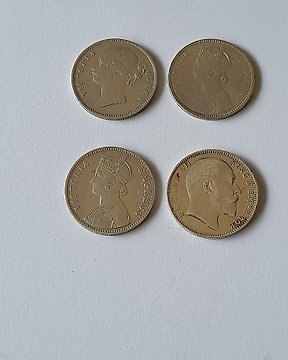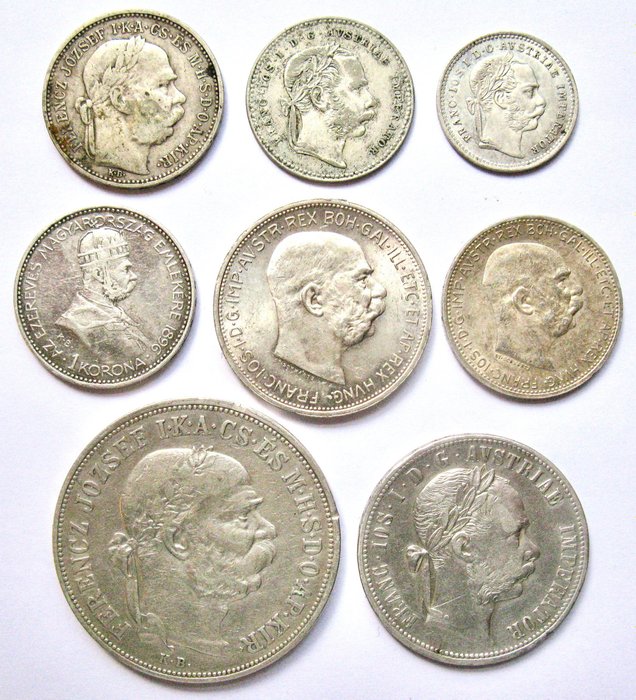
Brit India. Collection of Rupee 1840
Nr. 83149091

Nr. 83149091

Must be seen - please have a look at the pictures
Austria, attractive lot with 8 different type silver coins minted during the reign of Franz Jospeh.
5 Korona 1900
2 Korona 1912
1 Korona 1895 1896 and 1915
1 Florin 1879
20 Kreuzer 1868 and 10 Kreuzer 1872
Please have a look at our other Catawiki auction lots for more coin collections. and/or add us to your favourites to find our future auction lots easily.
Bid with confidence. AG-Worldcoins, over 3000 lots sold on Catawiki. High feedback score.
Please evaluate this lot with reference to the images provided.
Will be sent via registered mail.
I charge only 1x shipping costs when you buy multiple lots in the same auction.
You are welcome to bid on my other items:
https://veiling.catawiki.nl/aanbod/hamaca
Extra Info:
The Republic of Austria, a parliamentary democracy located in mountainous central Europe, has an area of 32,374 sq. mi. (83,850 sq. km.) Capital: Wien (Vienna). Austria is primarily an industrial country. Machinery, iron, steel, textiles, yarns and timber are exported.
The territories later to be known as Austria were overrun in pre-Roman times by various tribes, including the Celts. Upon the fall of the Roman Empire, the country became a margravate of Charlemagne’s Empire. Premysl II of Otakar, King of Bohemia, gained possession in 1252, only to lose the territory to Rudolf of Habsburg in 1276. Thereafter, until World War I, the story of Austria was conducted by the ruling Habsburgs. During the 17th century, Austrian coinage reflected the geo-political strife of three wars. From 1618-1648, the Thirty Years’ War between northern Protestants and southern Catholics produced low quality, “kipperwhipper” strikes of 12, 24, 30, 60, 75 and 150 Kreuzer. Later, during the Austrian-Turkish War, 1660-1664, coinages used to maintain soldier’s salaries also reported the steady division of Hungarian territories. Finally, between 1683 and 1699, during the second Austrian-Turkish conflict, new issues of 3, 6 and 15 Kreuzers were struck, being necessary to help defray mounting expenses of the war effort.
During World War I, the Austro-Hungarian Empire was one of the Central Powers with Germany, Bulgaria and Turkey. At the end of the war, the Empire was dismembered and Austria established as an independent republic. In March 1938, Austria was incorporated into Hitler’s short-lived Greater German Reich. Allied forces of both East and West occupied Austria in April 1945, and subsequently divided it into 4 zones of military occupation. On May 15, 1955, the 4 powers formally recognized Austria as a sovereign independent democratic state.The Principality of Liechtenstein, located in central Europe on the east bank of the Rhine between Austria and Switzerland, has an area of 62 sq. mi. (160 sq. km.) and a population of 27,200. Capital: Vaduz. The economy is based on agriculture and light manufacturing. Canned goods, textiles, ceramics and precision instruments are exported.
The lordships of Schellenburg and Vaduz were merged into the principality of Liechtenstein. It was a member of the Rhine Confederation from 1806 to 1815, and of the German Confederation from 1815 to 1866 when it became independent. Liechtenstein’s long and close association with Austria was terminated by World War I. In 1921 it adopted the coinage of Switzerland, and two years later entered into a customs union with the Swiss, who also operated its postal and telegraph systems and represented it in international affairs. The tiny principality abolished its army in 1868 and has avoided involvement in all European wars since that time.
Hogyan vásárolhatok a Catawiki-n?
1. Fedezzen fel valami különlegeset
2. Tegye meg a legmagasabb licitet
3. Fizessen a biztonságos és védett rendszert használva